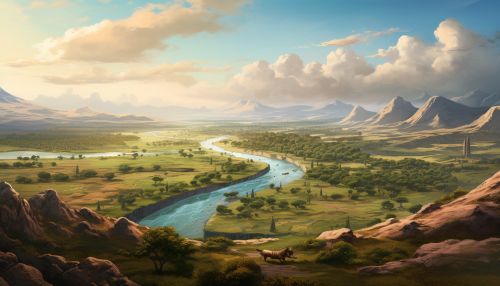Ancient Mesopotamia
Geography and Climate
Ancient Mesopotamia, often referred to as the "Cradle of Civilization," was located in the eastern part of the Fertile Crescent, a region in the Middle East which is today largely covered by the modern states of Iraq and Syria. The region is characterized by its fertile land, thanks to the rivers Tigris and Euphrates, which provided the necessary water supply for agriculture. The climate of Mesopotamia was generally hot and dry, but the rivers provided a source of irrigation, allowing for the growth of crops and the development of early civilizations.


Early History
Mesopotamia is home to some of the earliest known civilizations in history, with evidence of human activity dating back to the Paleolithic era. The region saw the rise of the Sumerian civilization around 4500 BCE, which is credited with many firsts in human history, including the invention of writing. The Sumerians were followed by the Akkadian, Babylonian, Assyrian, and Persian empires, each leaving their mark on the region's history and culture.
Sumerians
The Sumerians are considered the creators of civilization as modern humans understand it. They invented cuneiform writing, the wheel, the plow, and the sailboat. They developed a numerical system based on the number 60 that is still used to measure time and angles. The Sumerians were also known for their art and architecture, with the ziggurats being one of their most notable architectural achievements.
Akkadian Empire
The Akkadian Empire, established by Sargon of Akkad, was one of the first empires in history. It was a multi-ethnic and multi-lingual state, with Akkadian and Sumerian being the primary languages. The empire saw significant advancements in art, literature, and science.
Babylonian Empire
The Babylonian Empire is perhaps best known for the reign of Hammurabi, who is famous for the development of one of the world's oldest known code of law, the Code of Hammurabi. The Babylonians also made significant contributions to mathematics and astronomy.
Assyrian Empire
The Assyrian Empire was known for its military prowess and architectural achievements. The empire's capital, Nineveh, was one of the largest cities in the world at its height. The Assyrians also developed a library system, with the most famous being the library of Ashurbanipal at Nineveh.
Persian Empire
The Persian Empire, also known as the Achaemenid Empire, was the last great empire of ancient Mesopotamia. The empire was known for its tolerance of diverse cultures and religions, its effective bureaucratic system, and its construction projects, including the Royal Road and the qanat irrigation system.
Religion
Religion played a significant role in the societies of ancient Mesopotamia. The Mesopotamians believed in a pantheon of gods, with each city having a patron deity. Some of the most important deities included Anu, the sky god; Enlil, the god of wind; and Inanna, the goddess of love and war. Temples dedicated to these gods were central to city life, serving not only as places of worship but also as centers of economic and political activity.
Legacy
The civilizations of ancient Mesopotamia left a lasting legacy on the world. Their inventions and innovations, from writing to the wheel, have had a profound impact on human history. The region's rich history and cultural heritage continue to be studied and admired to this day.
